Welcome to another Guest Review Wednesday on Okazu. Today we we’re bringing back Christian LeBlanc, with a very enthusiastic review of a game he has not shut up about on the Okazu discord! ^_^ I was very much looking forward to his review of this game and he does not disappoint. Get comfortable and let Christian convince us all that this is a great game!
Blue Reflection: Second Light (Blue Reflection: Tie in Japan) available on Nintendo Switch, Playstation 4, and PC/Steam (screencaps and review based on Nintendo Switch version)
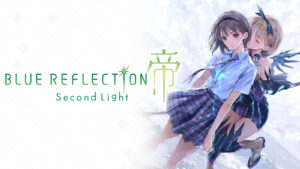
I’m going to start this review by touching on three very important points right off the bat:
- Yes, it’s Yuri
- There is, at least in my opinion, a positive depiction of someone with autism
- You need to play this game.
With that out of the way, let’s take our time and expand on this a little. Blue Reflection: Second Light (from developers Gust) is a JRPG, Yuritopian, slice-of-life, magical-realism, end-of-the-world, light-feeling comedy/romance/sci-fi/isekai/mystery with a touch of visual novel/dating sim where you and the other magical girls (called Reflectors here) have to figure out why you’ve been transported to an empty school, surrounded by water, and without your memories. And look for a way back home, of course.
I don’t even know where to begin with all that. Ok, it’s a dating sim?
Well, it’s not actually a dating sim per se; but you do spend a fair bit of time on dates with the other girls resulting in Fragments you can equip, powering up their Technique Points to spend on abilities, stat boosts, etc. And they’re not really dates so much as hang-outs: maybe you need to fetch something upstairs together, or you may both decide to visit one of the booths, or someone wants to see the wind generator you’ve built, etc. So it’s a JRPG, but you also just hang out a lot.
Wait, did you just say you build a wind generator?
Yeah, you also get Technique Points when you fulfill requests for people: someone might ask you to find an item for them, or build something for them like a beach chair, or a wind generator, a grand piano, a train platform…Ao’s real handy, what can I say!
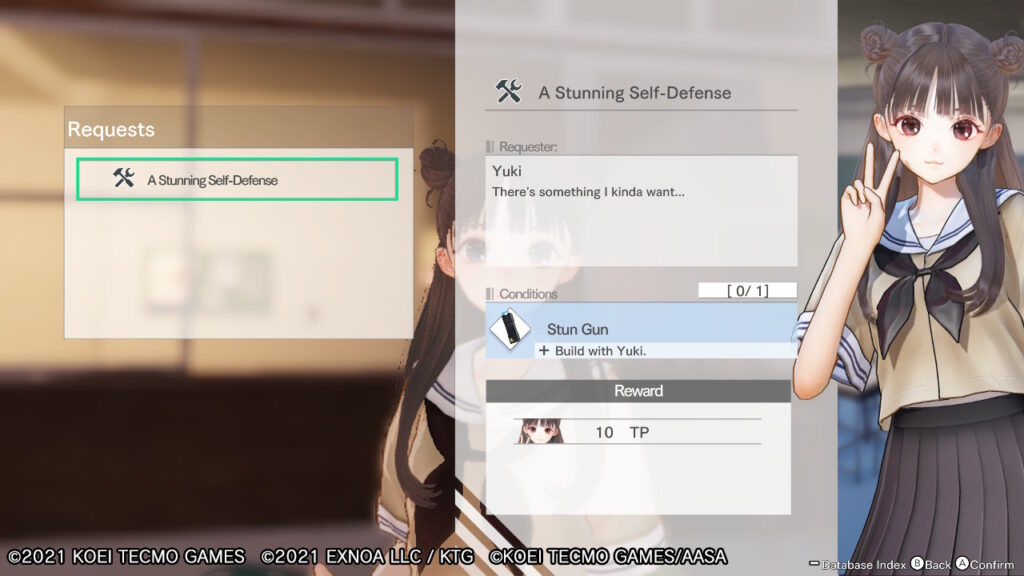
Ao?
Ao Hoshizaki, the main character you play as. She’s actually the only one who shows up at this school with her memories intact, and she kind of ends up being the Usagi Tsukino of the group. The designers even give you rabbit ears if you pre-ordered, or a rabbit on your head if you clear the free demo (PS4 or Switch only).
Wait, so they’re like “Thank you for supporting us with a pre-order, please enjoy these cute bunny ears. Oh, you held out for the free demo? Here, try not to let this thing crap down the back of your shirt I guess.”
I mean it’s still cute, but, yeah, I see where you’re coming from. Anyway, getting back to the dates – they’re just hang-outs, but you learn a lot about the other characters, you get closer to everyone, and you can flirt like crazy or be more chill (some characters flirt right back, turning the tables on Ao). You get occasional dialogue choices, but the conversations end up at the same place regardless of what you choose.
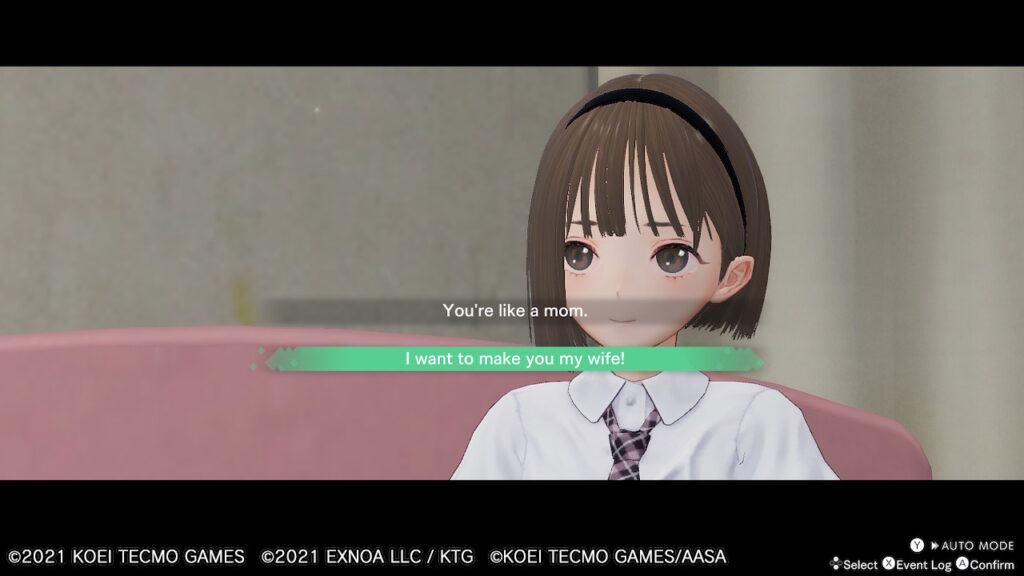
Oh, and you walk around holding hands after you’ve spent enough time with someone! And there’s cinematic cut-scenes. Actually, the whole game has these animated cut-scenes that move the story along, it’s really fun. The camera’s swinging around and zooming in, or cutting between characters – I actually really like the direction they take. These story beats happen during dates, during plot scenes, during Heartscape explorations…they’re all animated computer graphics, and everyone’s real expressive, and –
Wait, you said you hold hands?
Yeah, there’s a fair bit of hand holding! It’s just so…cute!
So is this game LGBTQ+?
Well, mostly. It’s a Yuritopia, where it’s more or less assumed that everyone is into girls, boys don’t exist, and where hand-holding is just an expression of closeness. I just resolved to take the flirting and hand-holding for what it was and enjoy it, but then – we get an actual Yuri relationship in the game!
Yuri confirmed!
Yuri confirmed! Lol. By Okazu standards, it’s lesbian content without lesbian representation, and that’s fine. Honestly, the whole game plays out like a really good Yuri series, so I feel like this will be the first time that some players experience the sweetness that Yuri manga excels at. And also the first time they see a lesbian relationship portrayed with the emotion and sincerity of Yuri, and the first time they see everyone else in a game treat this relationship as just normal (which it is), and I think that’s really cool.
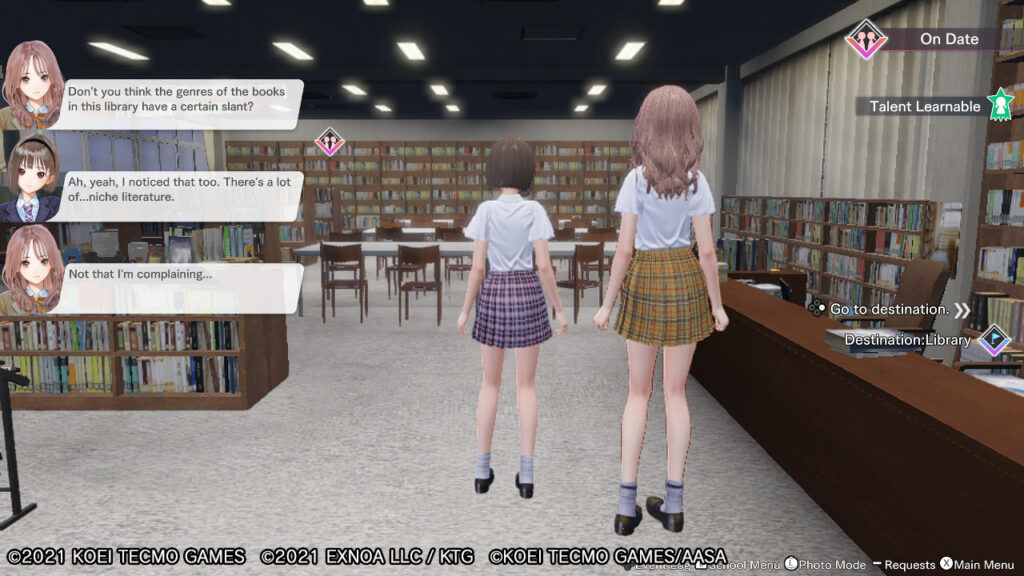
Getting back to our girl Ao: so she macks on every girl within eyesight?
No, that’s silly…she’s got a cel phone, you don’t have to establish line of sight for her to start flirting.
Well, as long as she knows her way around a good wind turbine, I guess. You gotta bring something to the table, right? So she’s really building all these facilities to impress the ladies?
Well, some of it ties into the plot, too, but I don’t want to spoil anything.
Gotcha. So is there a lot of grinding? Like do you have to keep fighting and fighting to level up before you can leave an area, or save up to buy equipment?
No, just start fights with the enemies you see on the map until you start to feel overpowered and the experience points don’t do much anymore, and then you can just run past the other enemies if you want. You make your own items (there’s a robust crafting system that I mostly ignore until the plot needs me to make something), and there’s no weapons or armor to buy. Everyone fights with the weapons they start the game with: scythe, sword, shotgun, etc. Everything’s marked on the map for you, too: items, enemies, bosses, etc.
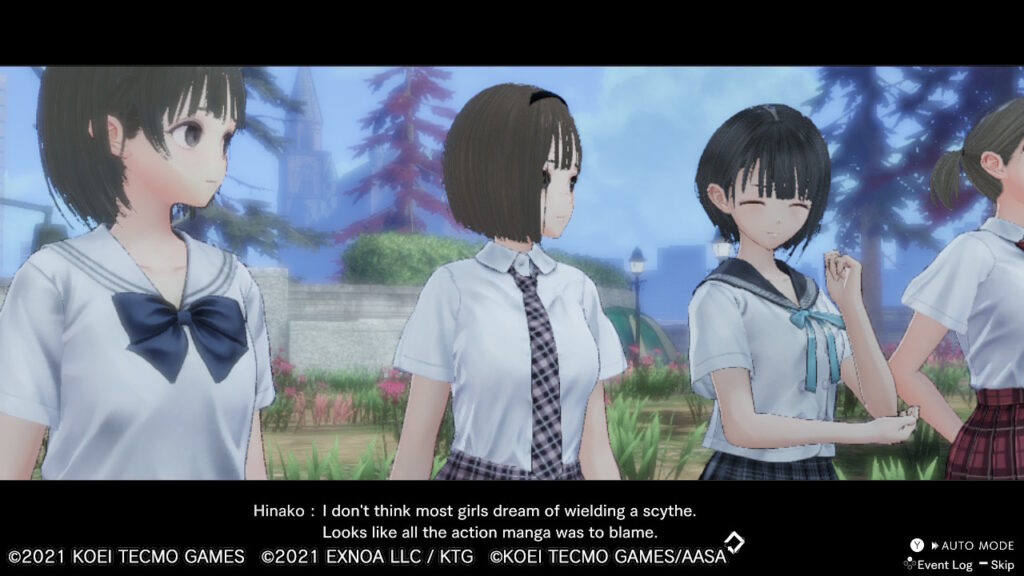
That’s convenient.
It is. Actually, there’s a lot of design choices in this game that favor convenience, so you can just enjoy the story and dialogue and interactions without getting needlessly frustrated or held back.
So the gameplay is pretty simple.
Well, it is, and it isn’t. My last JRPG was when Final Fantasy was still in single digits, so my learning curve was a bit longer than someone else’s would probably be. But once I got the hang of everything, I ended up actually enjoying the fights and stat boosts and all the nuts and bolts. The gameplay doesn’t just feel tacked on, is what I’m saying. They didn’t skimp on it. But yeah, getting back to convenience: you can just menu your way out of a Heartscape, teleport your way around the school or to a specific character, only watch Magical Girl transformation sequences once a level, etc. And when you’re exploring a Heartscape, you and your whole girl gang ride or die together, so everyone in your party levels up at the same time, even though you’re only fighting with three characters at once.
What are Heartscapes, like the dungeons?
Pretty much. Every character ends up getting their own Heartscape to explore, searching for their lost memories until you fight the boss and get some closure. Each Heartscape is tailored to each character, so it represents them and their memories. It’s symbolism! Beautiful symbolism, actually – Blue Reflection gleans a lot of its character from just how creative and pretty these internal landscapes are.
When you say there’s geography that symbolizes people and you recover memories and there’s an abandoned schoolhouse, I’ll be honest, my mind is going to Silent Hill. This isn’t horror or anything, is it?
I thought that too when I started playing it, but no. I don’t know if it’s intentionally trying to subvert all that, but it treats getting your memories back as a good thing. What you uncover means a lot to the characters, and it can be affecting or touching, but there’s no real trigger warnings I can think to give out. There’s a little bullying in the first set of flashbacks, but it’s kid stuff, nothing real traumatic or anything. Like I say, there’s generally a ‘light’ tone to everything. Sometimes it gets SERIOUS, but never super heavy or anything. Except when it does!
Like when you were up playing this game until 2:30 that one night and sniffling?
…One of the later chapters does *not* hold back. It’s so good. I just couldn’t put it down. And the audio helps out a lot with that. There’s a lot of voice acting in the game, and it’s quite well done. You can really hear the difference when a character lets their guard drop, for example. (This is all in Japanese by the way, subtitled in English.)
How about the music?
It is totally artcore!
Did you just make that up?
No, it’s a thing! Strings, piano and high-energy electronics and beats. Well, those are for the fights; a lot of the game’s music is more chill. The score is mature, but also playful, emotionally resonant, thrilling, intelligent – it enhances what’s going on in the game, or a certain character, but without feeling manipulative. Apparently the first game’s soundtrack is supposed to be even better, and, well, the mind boggles, because I love this soundtrack so hard. A lot of the themes repeat but in different moods, some tunes are re-works of themes from the first game – it’s just really cohesive, you know?
I get it. So who did the music?
Hayato Asano. They also did the score for the first Blue Reflection and those Atelier Ryza games, which are apparently a sister series to BR? I’ve never played them, but there’s DLC you can get that ties into it. Anyway, yeah, the music reminds me of something Sailor Neptune would have composed, which fits, because this is a magical girl game after all.
And speaking of magical girls, you can really feel Sailor Moon’s DNA in little ways in this game. Not just because magical girls in general, but the way Ao is there for everyone, and also how everyone interacts when they’re not fighting. One of my favorite aspects of Sailor Moon is when they all hang out together outside of fights, how they’re free to goof around and just play off one another. There’s a lot of that in this game.
Actually, this was honestly the first time I felt really sad when the game was over because I knew I wouldn’t be hanging out with these characters anymore. Like when you finish a really good book and you’re basking in that feeling afterwards. This very easily could have been an epic sci-fi Yuri manga series, except it’s all in one video game instead, and, I think that this story and these characters just work better as a game – although I’d still buy the hell out of a manga adaptation, if they ever made one.
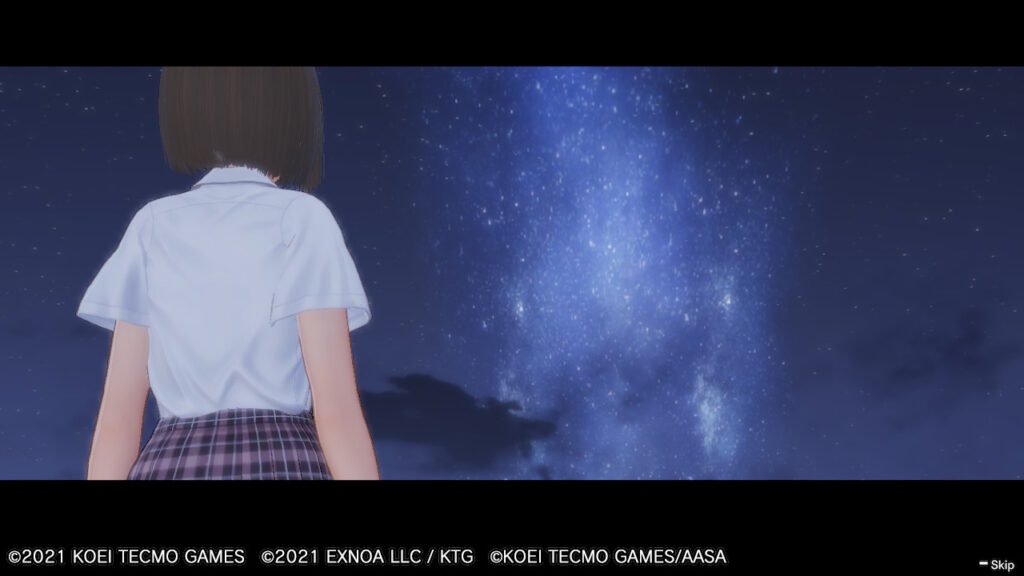
Everyone just feels so well-developed. Some of them suck at sports while blowing off steam at the gym, while others get way too into it, some of them do fan-fiction, some of them are shounen manga nerds – they talk about foods they like, what they want to be, problems they’re struggling with – everyone just seems so well-rounded and well-realized in the end.
There’s also, in my opinion at least, a really positive portrayal of autism in the game. And I haven’t really seen many people mentioning this online, so I think it’s important that more people know about it.
Is it just, like, this person is autistic! And then they fade into the background, or…
No, actually! Well, firstly, the game never comes out and says she’s autistic, but the way she says she doesn’t experience emotions like most people do, and the way she info dumps on Ao when they’re talking about one of her interests, I think you’re meant to infer. And I didn’t know enough about it to assume, so I looked up information online and actually learned a few things, which made me appreciate the character a lot more – and the game, for getting me to learn more about autism.
That’s cool.
It really is. Like, at first you think she might have alexithymia, which is the absence of emotions, but then you start thinking it could just be a smaller touch of that, along with the idea of someone just processing emotions differently from everyone else. The character is figuring all this out as they’re getting their memories back, and Ao and the others are really supportive – for a magical girl game where Emotions are a form of energy and power, it’s fascinating exploring a character who claims at first not to have any. And I realize that different people will have their own take on this depiction, but it just feels so positive to me that I can’t help thinking this had to be a very close topic for someone who worked on the game. In terms of who you end up shipping Ao with by the time the game is winding up, this person is on equal footing with everyone else. They’re not marginalized within the game, I feel.
So if you like this game so much, are you going to go back and play the first one now?
Yes. Although I heard that this game improves on almost everything: gameplay, playable characters, there’s way less fanservice in this game…I’m not saying it’s service-free, even if they try to avoid it in weird ways…there are shower scenes but everyone’s wearing one-piece swimsuits and talking to each other, so, everyone’s a never-nude, I guess? White dress shirts get wet, but you don’t see much. But there’s so many times you see a character jumping or sliding without the obligatory panty shot that it *does* stand out.
Like the notes you don’t play in jazz – it’s not about the service you see, it’s about the service you *don’t* see.
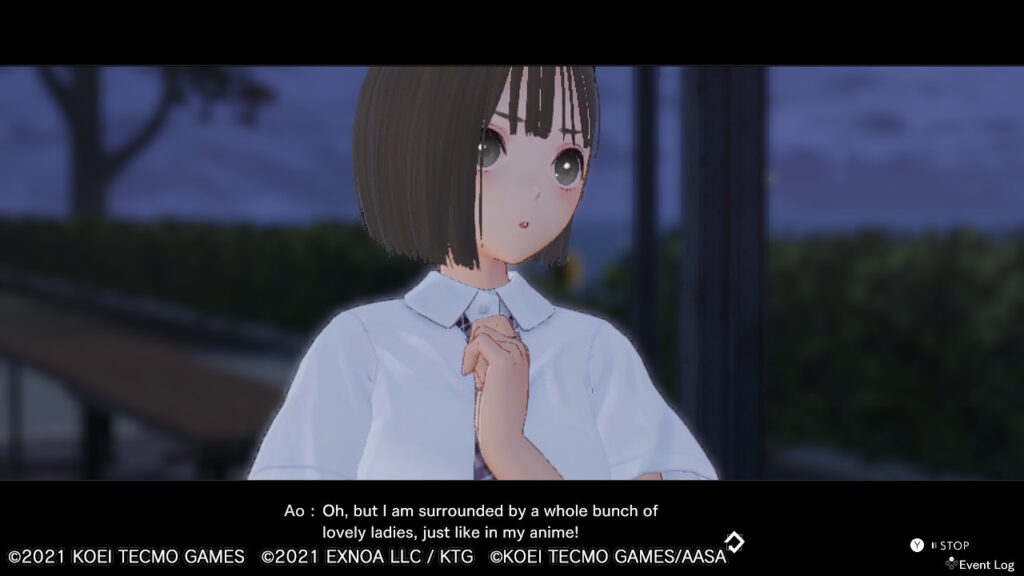
There’s an anime as well (Blue Reflection: Ray, as reviewed by Aurakin), and some characters from the first game and anime return here. There’s also going to be a mobile game, Blue Reflection: Sun.
Was there anything you didn’t like? You’re overwhelmingly positive here, are you sure you’re not just hyper-fixating on something you’re taken with and ignoring the negatives?
Well, to be fair, sometimes you’ll get really into the story and want to progress and fight, but the girls keep interrupting you for obligatory story dates, so depending what you’re in the mood to do, that can get a little frustrating. Also, sometimes the game wants you to go on stealth missions which can get a little unfair in the later levels. If you keep saving your progress, that will help with that, though.
My biggest complaint is that the game wants you to play through it again after you beat it in order to get the “true” ending, as well as go on more dates etc. that you weren’t able to the first time around – I think most people will just end up going to YouTube for that kind of content, though. Although I’ll admit, I’m actually enjoying my second playthrough, seeing what happens when you make different dialogue choices, enjoying the story with the full knowledge of everything that happens, etc.
Ratings:
Art – 9 Wonderful character designs by Mel Kishida, and hauntingly gorgeous landscapes of imagination to explore. Where Silent Hill goes bleak, Blue Reflection goes in the opposite direction.
Music – 9 Hayato Asano does a fantastic job with the themes in this game.
Characters – 10 I love any piece of media that allows their characters to be dorks sometimes.
Story – 10 The underlying sci-fi mystery is very compelling, and the way everyone interacts with each other is charming a.f. All of the writing awards for Akiko Waba, please. I haven’t touched much on the plot besides introductory set-up because there’s a lot of fun in working your way through and discovering what’s going on.
Yuri – 8 I repeat: this is a Yuri manga in JRPG form. Also, the couple sometimes ask others for relationship advice, which is great to see.
Service – 3 as a base level; there’s some questionable camera work from time to time. You can dress everyone up in one-piece swimsuits if you like, as well as a two-piece for Ao, which bumps us up to a 5. There are also DLC costumes for everyone you can buy, with everything from animal ears to maid costumes to revealing swimsuits, which would probably ramp us up to a 7 or 8?
Overall – 10. I foresee this game achieving cult status, where those who have played it, really love it.

Erica here: I’m sold! I really wish I played games, because this sounds fantastic. One day I’ll have to watch a playthrough. ^_^ Thanks so much Christian for this terrific review.
![]() Once again, I am extremely pleased to welcome Megan back for a Guest Review here on Okazu. This summer has been magnificently busy and I’m thrilled to welcome Megan back to have her thoughts on this anime!
Once again, I am extremely pleased to welcome Megan back for a Guest Review here on Okazu. This summer has been magnificently busy and I’m thrilled to welcome Megan back to have her thoughts on this anime!

